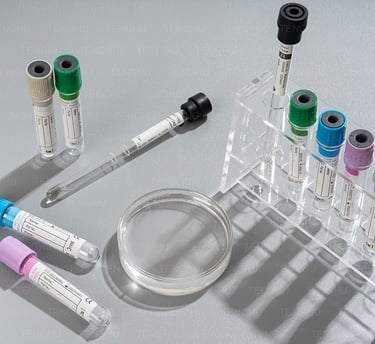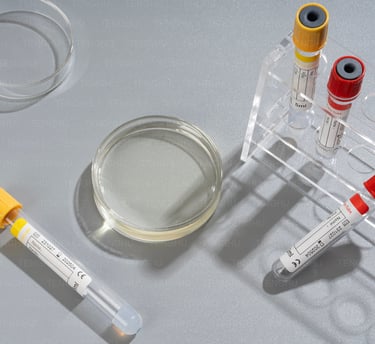The Hidden Science Inside Every Test Tube: Understanding Separation Gel, Coagulants, Anticoagulants, and the Unsung Heroes—Auxiliary Additives
MEDICAL EQUIPMENT&PRODUCTS
5/19/20254 min read


Introduction: More Than Just Blood in a Tube
When we think about blood tests, our minds often drift to sterile labs, white-coated technicians, and the occasional uncomfortable needle prick. Rarely, however, do we consider what happens after the blood is drawn. What ensures that your sample remains stable, separable, and analyzable? That question opens the door to a world filled with high-precision materials and chemical ingenuity. At the heart of this hidden science are four key players: separation gel, coagulants, anticoagulants, and auxiliary additives. Together, they form the unseen but essential ecosystem behind reliable blood diagnostics.
This blog dives deep into the unique roles, compositions, and interactions of these substances. Whether you're in the medical industry, a healthcare enthusiast, or simply curious about how your blood sample transforms into data—this is your backstage pass.
What Is Separation Gel, and Why Is It So Important?
Separation gel may look like an inconspicuous, colorless blob in a test tube, but its role is nothing short of revolutionary. Once centrifuged, this gel forms a physical barrier between serum or plasma and blood cells, thereby enabling accurate analytical testing.
Composition and Chemistry
Typically made from a blend of polymers and inert oils, separation gels have a specific gravity carefully calibrated to position them between the blood's cellular components and the liquid plasma/serum. When centrifuged, the denser red and white blood cells sink below the gel, while the lighter plasma or serum floats above.
Applications
Clinical chemistry
Immunology tests
Serology
Hormone analysis
Innovations in Separation Gel
Modern separation gels incorporate temperature resistance and chemical stability, making them compatible with a wider range of tests and storage conditions. Some even include anticoagulants for dual functionality.
Coagulants: Accelerating Nature’s Blood-Stopping Trick
When quick serum separation is needed, coagulants step in. These agents speed up the natural clotting process, helping blood transform into a solid mass more quickly, thereby isolating the serum.
Common Coagulants
Silica particles: Act as activators for the clotting cascade.
Thrombin: A potent enzyme that converts fibrinogen into fibrin.
Kaolin: Often used in coagulation testing.
How Coagulants Work
By activating platelets or stimulating the conversion of fibrinogen to fibrin, coagulants induce the formation of a clot. This allows labs to centrifuge the sample much faster, separating the serum for analysis within minutes.
Applications
Emergency diagnostics
Rapid hormone testing
STAT blood work
Safety and Stability
Modern coagulants are designed to avoid contamination and ensure sample stability over time. Some even come embedded in the walls of collection tubes, activating only upon blood contact.
Anticoagulants: The Freeze-Frame Artists of Blood
While coagulants induce clotting, anticoagulants are their polar opposites. These compounds prevent clotting, keeping the blood in a fluid state. This property is vital for tests that require intact cells or plasma.
Types of Anticoagulants
EDTA (Ethylenediaminetetraacetic acid): Chelates calcium ions, essential for clotting.
Heparin: Inhibits thrombin and other clotting factors.
Citrate: Binds calcium reversibly, often used in coagulation studies.
Oxalates: Form insoluble complexes with calcium.
How They Work
By interrupting the calcium-dependent clotting pathways, anticoagulants keep the blood from forming clots. This allows for tests like:
Complete blood count (CBC)
Coagulation profile
Blood gas analysis
Glucose and lactate measurements
Balancing Act
Choosing the right anticoagulant is a delicate science. An inappropriate choice can ruin the sample. For example, EDTA is perfect for hematology but disastrous for calcium level testing due to its chelating nature.
Auxiliary Additives: The Unsung Heroes
If the previously mentioned components are the lead actors, auxiliary additives are the supporting cast that ensures a flawless performance. These compounds optimize sample quality, storage conditions, and test accuracy.
Types and Functions
Stabilizers: Protect sensitive analytes like glucose.
Preservatives: Prevent microbial contamination.
Buffers: Maintain pH levels.
Surfactants: Improve mixing and prevent clot adherence.
Where They Shine
Auxiliary additives may be specific to particular tests. For example, fluoride is used as a glycolysis inhibitor in glucose testing tubes. Without such additives, glucose levels would decrease rapidly post-sampling, leading to inaccurate results.
The Dance of Interactions: How These Substances Work Together
The interplay between separation gel, coagulants, anticoagulants, and auxiliary additives determines the success of every diagnostic procedure.
Case Study: Serum Separator Tube (SST)
In an SST, the tube often includes both a coagulant and a separation gel. Once the blood is drawn, the coagulant initiates clotting, and after centrifugation, the gel forms a barrier between the serum and cells. This double-action ensures rapid, uncontaminated serum extraction.
Conflict Zones
Sometimes, these substances can clash. For instance, adding a separation gel in a tube with EDTA might not produce the desired separation, especially if the density is miscalibrated.
Quality Control and Regulatory Considerations
Medical-grade separation materials and additives undergo rigorous quality checks. These include:
Sterility testing
Endotoxin level monitoring
Stability tests across temperatures
Batch-to-batch consistency audits
Additionally, products must comply with regulatory frameworks like ISO 13485, CE marking, or FDA clearance, depending on the region.
Trends and Innovations: What the Future Holds
As diagnostics advance, so do the demands on these substances. Future trends include:
Smart additives: Responsive to environmental changes
Multi-functional tubes: Capable of both serum and plasma analysis
Sustainable materials: Biodegradable gels and additives
Miniaturization: Microfluidic-compatible additives for point-of-care devices
Conclusion: The Symphony Behind the Scenes
Next time you get your blood drawn, take a moment to appreciate the symphony of science occurring silently in that tiny tube. From the separation gel that forms a protective layer, to the coagulants and anticoagulants that orchestrate fluid dynamics, and the auxiliary additives that fine-tune the entire performance—each plays a pivotal role.
These substances may never make headlines, but without them, modern diagnostics would be impossible. They are the backbone of laboratory medicine, ensuring that what’s invisible inside us becomes visible, understandable, and treatable.


